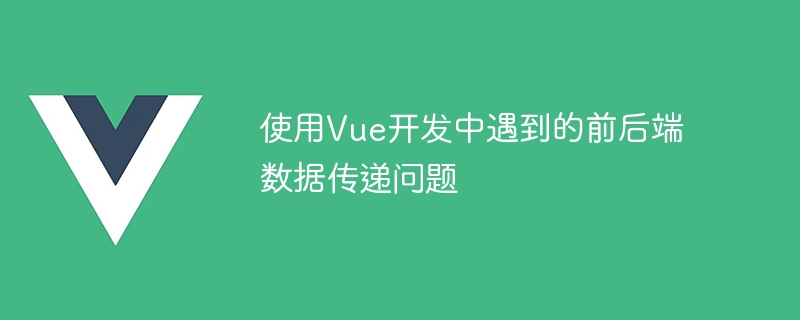Home >Web Front-end >Vue.js >Front-end and back-end data transfer problems encountered in Vue development
Front-end and back-end data transfer problems encountered in Vue development
- PHPzOriginal
- 2023-10-08 13:25:081455browse

The front-end and back-end data transfer problems encountered in Vue development require specific code examples
With the development of front-end technology, Vue is a popular front-end framework , more and more developers choose to use Vue for web application development. In the Vue development process, the transmission of front-end and back-end data is a very important link. This article will introduce some common front-end and back-end data transfer problems in Vue development, and provide specific code examples to solve these problems.
- The front-end and back-end data transfer formats are not unified
In the process of front-end and back-end data transfer, the format of the data is often a key issue. Front-end and back-end developers need to ensure that the data format is unified so that the data can be transferred and processed smoothly. A common solution is to use JSON as the format for data transfer.
Front-end code example:
<template>
<div>
<button @click="getData">获取数据</button>
<div v-for="item in data" :key="item.id">{{ item.name }}</div>
</div>
</template>
<script>
export default {
data() {
return {
data: []
}
},
methods: {
async getData() {
try {
const response = await this.$http.get('/api/data');
this.data = response.data;
} catch (error) {
console.error(error);
}
}
}
}
</script>Back-end code example (using Node.js and Express framework):
app.get('/api/data', (req, res) => {
const data = [
{ id: 1, name: '数据1' },
{ id: 2, name: '数据2' },
{ id: 3, name: '数据3' }
];
res.json(data);
});In the above example, the front-end triggers fetching data by clicking a button method, and then interacts with the backend through HTTP requests. The backend returns data in json format, and the frontend renders the data into the page through Vue's data binding mechanism.
- Cross-domain issues
In development, the front-end and back-end are often deployed on different servers. Due to security reasons, the browser has a same-origin policy, resulting in the front-end API interfaces from different sources cannot be requested directly. This requires solving cross-domain issues. One solution is to set CORS (Cross-Origin Resource Sharing) response headers on the backend.
Backend code example (using Node.js and Express framework):
// 设置允许跨域访问的域名
app.use((req, res, next) => {
res.setHeader('Access-Control-Allow-Origin', 'http://localhost:8080');
res.setHeader('Access-Control-Allow-Headers', 'Content-Type');
next();
});
// 定义API接口
app.get('/api/data', (req, res) => {
const data = [
{ id: 1, name: '数据1' },
{ id: 2, name: '数据2' },
{ id: 3, name: '数据3' }
];
res.json(data);
}); In the above example, by setting the res.setHeader method, cross-domain access will be allowed The domain name is set to the domain name and port of the front-end development server. This allows the front-end to request the back-end API interface normally.
- Submission of form data
During development, we often encounter situations where we need to submit form data to the backend for processing. Vue provides a convenient form data binding mechanism, making the acquisition and submission of form data very simple.
Code example:
<template>
<div>
<input type="text" v-model="name">
<button @click="submitForm">提交</button>
</div>
</template>
<script>
export default {
data() {
return {
name: ''
}
},
methods: {
async submitForm() {
try {
const response = await this.$http.post('/api/submit', { name: this.name });
console.log(response.data);
} catch (error) {
console.error(error);
}
}
}
}
</script>Backend code example (using Node.js and Express framework):
app.post('/api/submit', (req, res) => {
const name = req.body.name;
// 处理表单数据
res.json({ message: '表单数据已提交' });
}); In the above example, by using v-model Instruction to bidirectionally bind form elements to Vue instance data. After binding, use this.name to get or modify the value of the form element. When the submit button is clicked, the form data is sent to the backend for processing through an HTTP request, and the backend returns the processing results.
Summary:
In Vue development, front-end and back-end data transfer is a very important link. This article describes some common front-end and back-end data transfer issues and provides specific code examples to solve them. By following a unified data transmission format, solving cross-domain issues, and using Vue's form data binding mechanism, front-end and back-end data transmission and processing can be effectively completed.
The above is the detailed content of Front-end and back-end data transfer problems encountered in Vue development. For more information, please follow other related articles on the PHP Chinese website!
Related articles
See more- In-depth understanding of Bootstrap table table plug-in (2) front-end and front-end paging fuzzy query
- How to implement data transfer between several forms in Javascript?
- Detailed explanation of the use of created method in vue.js
- vue scaffolding installation steps
- Using ThinkPHP6 to achieve front-end and back-end separation

